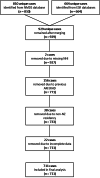Estimating the risk of acute rheumatic fever in New Zealand by age, ethnicity and deprivation
- PMID: 27311633
- PMCID: PMC9150400
- DOI: 10.1017/S0950268816001291
Estimating the risk of acute rheumatic fever in New Zealand by age, ethnicity and deprivation
Abstract
In New Zealand, efforts to control acute rheumatic fever (ARF) and its sequelae have focused on school-age children in the poorest socioeconomic areas; however, it is unclear whether this approach is optimal given the strong association with demographic risk factors other than deprivation, especially ethnicity. The aim of this study was to estimate the stratum-specific risk of ARF by key sociodemographic characteristics. We used hospitalization and disease notification data to identify new cases of ARF between 2010 and 2013, and used population count data from the 2013 New Zealand Census as our denominator. Poisson logistic regression methods were used to estimate stratum-specific risk of ARF development. The likelihood of ARF development varied considerably by age, ethnicity and deprivation strata: while risk was greatest in Māori and Pacific children aged 10-14 years residing in the most extreme deprivation, both of these ethnic groups experienced elevated risk across a wide age range and across deprivation levels. Interventions that target populations based on deprivation will include the highest-risk strata, but they will also (a) include groups with very low risk of ARF, such as non-Māori/non-Pacific children; and (b) exclude groups with moderate risk of ARF, such as Māori and Pacific individuals living outside high deprivation areas.
Keywords: Public health; rheumatic fever; rheumatic heart disease.
Figures
Similar articles
-
Incidence of acute rheumatic fever in New Zealand children and youth.J Paediatr Child Health. 2012 Aug;48(8):685-91. doi: 10.1111/j.1440-1754.2012.02447.x. Epub 2012 Apr 12. J Paediatr Child Health. 2012. PMID: 22494483
-
Epidemiology of acute rheumatic fever in New Zealand 1996-2005.J Paediatr Child Health. 2008 Oct;44(10):564-71. doi: 10.1111/j.1440-1754.2008.01384.x. J Paediatr Child Health. 2008. PMID: 19012628
-
Retrospective epidemiology of acute rheumatic fever: a 10-year review in the Waikato District Health Board area of New Zealand.N Z Med J. 2014 May 2;127(1393):26-37. N Z Med J. 2014. PMID: 24816954
-
Risk Factors for Acute Rheumatic Fever: Literature Review and Protocol for a Case-Control Study in New Zealand.Int J Environ Res Public Health. 2019 Nov 15;16(22):4515. doi: 10.3390/ijerph16224515. Int J Environ Res Public Health. 2019. PMID: 31731673 Free PMC article. Review.
-
Structured review of primary interventions to reduce group A streptococcal infections, acute rheumatic fever and rheumatic heart disease.J Paediatr Child Health. 2021 Jun;57(6):797-802. doi: 10.1111/jpc.15514. Epub 2021 Apr 20. J Paediatr Child Health. 2021. PMID: 33876472 Review.
Cited by
-
COVID-19: we must not forget about Indigenous health and equity.Aust N Z J Public Health. 2020 Aug;44(4):253-256. doi: 10.1111/1753-6405.13015. Epub 2020 Jul 6. Aust N Z J Public Health. 2020. PMID: 32628335 Free PMC article. No abstract available.
-
Estimating the likely true changes in rheumatic fever incidence using two data sources.Epidemiol Infect. 2018 Jan;146(2):265-275. doi: 10.1017/S0950268817002734. Epub 2017 Dec 6. Epidemiol Infect. 2018. PMID: 29208066 Free PMC article.
-
Group A Streptococcus T Antigens Have a Highly Conserved Structure Concealed under a Heterogeneous Surface That Has Implications for Vaccine Design.Infect Immun. 2019 May 21;87(6):e00205-19. doi: 10.1128/IAI.00205-19. Print 2019 Jun. Infect Immun. 2019. PMID: 30936156 Free PMC article.
-
Risk factors for acute rheumatic fever: A case-control study.Lancet Reg Health West Pac. 2022 Jul 4;26:100508. doi: 10.1016/j.lanwpc.2022.100508. eCollection 2022 Sep. Lancet Reg Health West Pac. 2022. PMID: 36213134 Free PMC article.
-
Acute rheumatic fever and rheumatic heart disease in children and adolescents in Victoria, Australia.J Paediatr Child Health. 2023 Feb;59(2):352-359. doi: 10.1111/jpc.16305. Epub 2022 Dec 8. J Paediatr Child Health. 2023. PMID: 36478625 Free PMC article.
References
-
- Carapetis JR, et al. The global burden of group A streptococcal diseases. Lancet Infectious Diseases 2005; 5: 685–694. - PubMed
-
- Shaikh N, Leonard E, Martin JM. Prevalence of streptococcal pharyngitis and streptococcal carriage in children: a meta-analysis. Pediatrics 2010; 126: e557–e564. - PubMed
-
- Webb RH, Grant C, Harnden A. Acute rheumatic fever. British Medical Journal (Online) 2015; 351: h3443. - PubMed
-
- Milne RJ, et al. Incidence of acute rheumatic fever in New Zealand children and youth. Journal of Paediatrics and Child Health 2012; 48: 685–691. - PubMed
Publication types
MeSH terms
LinkOut - more resources
Full Text Sources
Other Literature Sources


